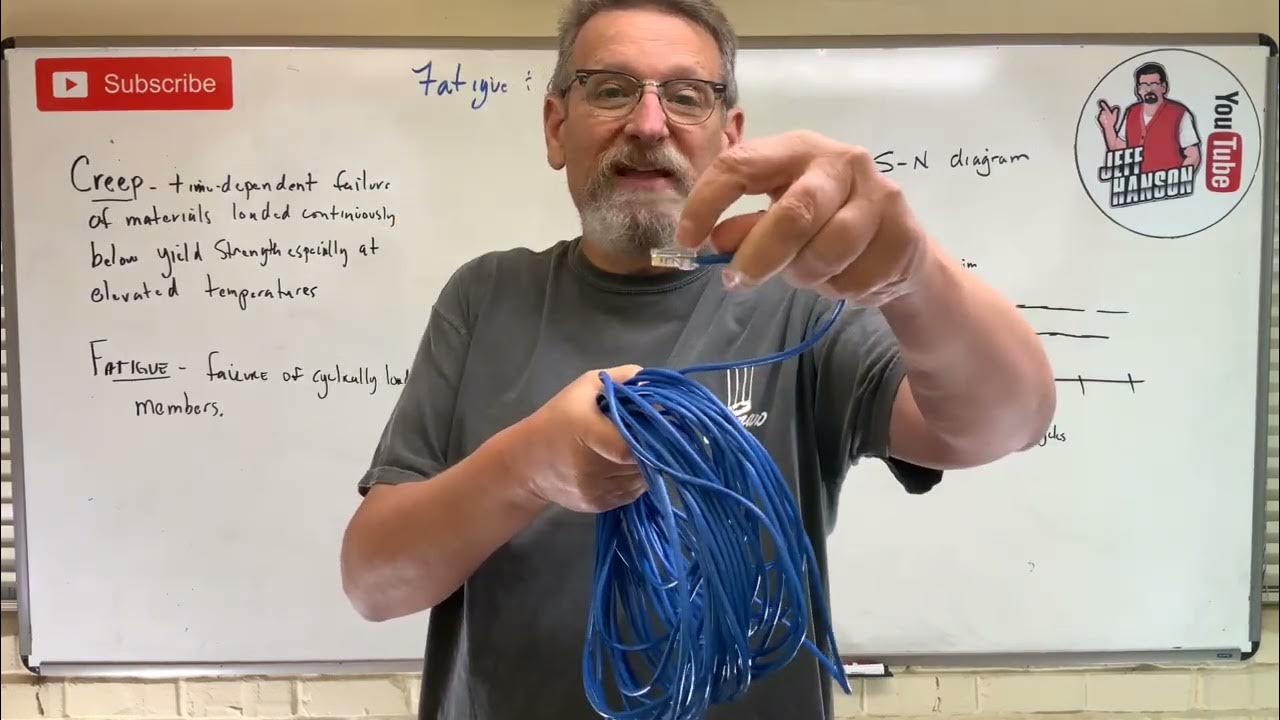Creep: Introduction
Summary
TLDRThis video explores the phenomenon of creep, a unique type of plastic deformation that occurs under constant stress over time. Using a demonstration with two springs, the concept of creep is illustrated as one spring elongates without additional weight. The video discusses various examples where creep occurs, such as in tungsten filament bulbs, glaciers, and jet engine turbine blades. It also introduces the creep curve, which has three stages—primary, secondary, and tertiary—and explains how temperature impacts the material’s behavior, making it significant at temperatures above half the melting point.
Takeaways
- 🔧 Creep is a type of plastic deformation that occurs over time under constant stress.
- 🌀 Shrikanth's demo shows that a spring deforms continuously over time due to its self-weight, demonstrating creep.
- 💡 Tungsten filament bulbs fail not by melting but by breaking due to creep over time.
- ❄️ Glaciers move through creep, where ice deforms slowly over time rather than just sliding.
- ✈️ The life of jet engine turbine blades is limited by creep, which causes deformation over time under high stress and temperature.
- 📉 Creep curves show strain as a function of time, with three stages: primary, secondary (steady-state), and tertiary.
- ⏳ The secondary stage of creep, or steady-state creep, is crucial in material design due to its constant strain rate.
- 🌡️ Creep is a high-temperature phenomenon, where the temperature relative to a material’s melting point plays a key role.
- 📐 Aluminum in the demo didn’t undergo creep because room temperature is too low compared to its melting point.
- 🔩 Creep becomes significant when the temperature exceeds 50% of the material's melting point, as seen with the solder wire in Shrikanth's demo.
Q & A
What is creep?
-Creep is a time-dependent plastic deformation that occurs under constant load or constant stress. It involves the continuous deformation of a material over time, even without increasing the applied load.
How does creep differ from regular plastic deformation?
-In regular plastic deformation, strain occurs instantly after a load is applied and remains fixed. However, in creep, deformation continues over time under a constant load. Creep also occurs more significantly at higher temperatures relative to the material’s melting point.
What are the three stages of creep?
-The three stages of creep are: 1) Primary (or transient) creep, where the strain rate decreases over time, 2) Secondary (steady-state) creep, where the strain rate is constant, and 3) Tertiary creep, where the strain rate accelerates, eventually leading to material failure.
What are some real-world examples where creep plays a significant role?
-Examples include the failure of tungsten filament bulbs due to creep, the movement of glaciers caused by ice deformation, and the limiting of jet engine turbine blade life, where high temperatures cause creep in the blades.
Why do tungsten filament bulbs fail?
-Tungsten filament bulbs fail due to creep. Over time, the tungsten filament experiences continuous deformation from the heat and eventually breaks, even though it doesn’t reach its melting point.
What is the importance of temperature in the creep phenomenon?
-Temperature is a critical factor in creep. Creep becomes significant at temperatures above 0.5 times the material's melting point. The same room temperature can cause creep in one material (e.g., solder) but not in another (e.g., aluminum) depending on their respective melting points.
What is the 'steady-state creep' or 'secondary creep' stage?
-Steady-state creep is the second stage of creep where the strain rate remains constant over time. This is the most critical stage for designing materials for creep resistance, as it represents a period of stable deformation before failure.
What role does time play in the creep phenomenon?
-Time is a key factor in creep. Unlike typical plastic deformation, which happens immediately after applying stress, creep occurs over time. The material continues to deform even if the load remains constant.
Why do glaciers move due to creep?
-Glaciers move because the ice in them undergoes creep deformation. Rather than sliding as a solid block, the ice slowly deforms under its own weight and the pressure exerted by the mass of ice, leading to gradual movement.
How does the melting point of a material affect its susceptibility to creep?
-The susceptibility of a material to creep depends on the ratio of the operating temperature to its melting point. Creep becomes significant when the temperature is greater than 0.5 times the melting point of the material (in Kelvin). For example, solder experiences creep at room temperature because this temperature is a high percentage of its melting point.
Outlines

Esta sección está disponible solo para usuarios con suscripción. Por favor, mejora tu plan para acceder a esta parte.
Mejorar ahoraMindmap

Esta sección está disponible solo para usuarios con suscripción. Por favor, mejora tu plan para acceder a esta parte.
Mejorar ahoraKeywords

Esta sección está disponible solo para usuarios con suscripción. Por favor, mejora tu plan para acceder a esta parte.
Mejorar ahoraHighlights

Esta sección está disponible solo para usuarios con suscripción. Por favor, mejora tu plan para acceder a esta parte.
Mejorar ahoraTranscripts

Esta sección está disponible solo para usuarios con suscripción. Por favor, mejora tu plan para acceder a esta parte.
Mejorar ahora5.0 / 5 (0 votes)






